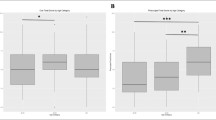Abstract
We report two young patients able to exist on exclusively oral intake despite an absent pharyngeal swallow response. Videofluoroscopic swallowing studies showed that both patients used a sequence of devised maneuvers rather than a coordinated pharyngeal swallow to move the bolus, protect the airway, and open the upper esophageal sphincter during bolus ingestion. We conclude that it is possible for young, highly motivated individuals to maintain oral intake despite ablation of neurologic elements crucial for the normal swallow response.
Similar content being viewed by others
References
Kahrilas PJ, Dodds WJ, Dent J, Logemann JA, Shaker R: Upper esophageal sphincter function during deglutition.Gastroenterology 95:52–62, 1988
Cook IJ, Dodds WJ, Dantas RO, et al.: Opening mechanism of the human upper esophageal sphincter.Am J Physiol 257: G748-G759, 1989
Jacob P, Kahrilas PJ, Logemann JA, Shah V, Ha T: Upper esophageal sphincter opening and modulation during swallowing.Gastroenterology 97:1469–1478, 1989
Logemann JA, Kahrilas PJ: Relearning to swallow post stroke—application of maneuvers and indirect biofeedback: a case study.Neurology 40:1136–1138, 1990
Kahrilas PJ, Logemann JA, Krugler C, Flanagan E: Volitional augmentation of upper esophageal sphincter opening during swallowing.Am J Physiol 260:G450-G456, 1991
Logemann JA, Kahrilas PJ, Begelman J, Dodds WJ, Pauloski BR: Interactive computer program for biomechanical analysis of videoradiographic studies of swallowing.AJR 153:277–280, 1989
Doty RW: Neural organization of deglutition. InHandbook of Physiology, Alimentary Canal. Section 6, vol 4. Washington, D.C.: American Physiological Society, 1968, pp. 1861–1902
Cerenko D, McConnel FMS, Jackson RT: Quantitative assessment of pharyngeal bolus driving forces.Otolaryngol Head Neck Surg 100:57–63, 1989
Shedd DP, Scatliff JH, Kirschner JA: The buccopharyngeal propulsive mechanism in human deglutition.Surgery 48:846–853, 1960
Author information
Authors and Affiliations
Rights and permissions
About this article
Cite this article
Kahrilas, P.J., Logemann, J.A. & Gibbons, P. Food intake by maneuver; An extreme compensation for impaired swallowing. Dysphagia 7, 155–159 (1992). https://doi.org/10.1007/BF02493449
Issue Date:
DOI: https://doi.org/10.1007/BF02493449




